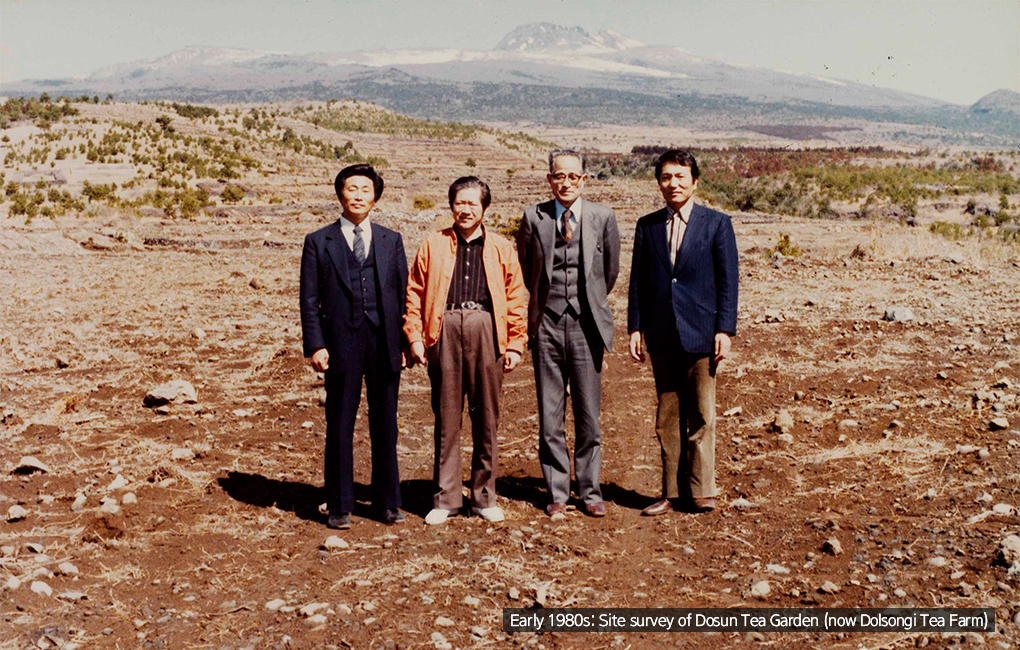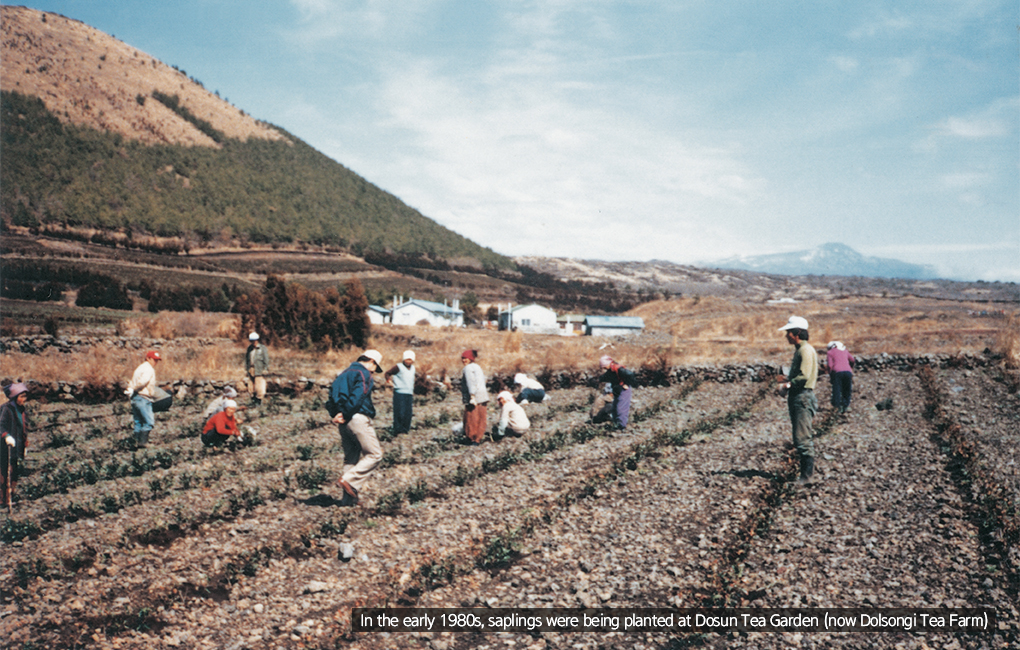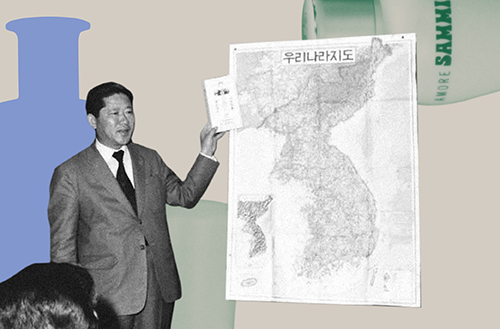

-
-
- 메일 공유
-
https://stories.amorepacific.com/en/amorepacific-a-lifelong-green-dream-nurtured-with-heart
A Lifelong Green Dream, Nurtured with Heart

“I want to start a tea business.
I know better than anybody that the tea business is not going to generate revenue immediately.
This is a cultural project.”

For the prosperity of the cosmetics industry and Pacific, Jangwon traveled extensively to various countries. No matter how packed and exhausting his schedule, he never neglected to immerse himself in the culture and natural beauty of each place. During moments of respite, sipping coffee or tea, Jangwon noticed a striking fact—no matter where he went, people had a profound love for tea. Observing Japan’s deep reverence for Goryeo and Joseon Dynasties tea bowls, he couldn’t help but feel a deep sorrow for the loss of Korea’s own tea culture.
One day, Jangwon realized that reviving tea culture was Pacific’s calling, and he made a firm decision. At a time when the once-flourishing tea culture had all but vanished, he resolved to restore it through the cultivation of green tea. Shifting his focus away from Pacific’s usual research and development of cosmetic products, Jangwon planted a cultural seed deep within his heart.
One day in 1979, Jangwon convened an emergency conference at the headquarters in Yongsan and declared, “I want to start a tea business. Director Hangwon Suh will head this new business venture.” Despite having studied enzymes in Japan after graduating from agriculture in college, Director Suh was left speechless by this statement. Not only was he uncertain about the success of a tea business, but he also had no taste for green tea during his studies in Japan, making him doubt whether this was the right role for him. However, Director Suh knew from experience that once Jangwon was not a man who could be talked out of something, there was no stopping him.
The well-thumbed Japanese books Jangwon handed over, which he had already reviewed, conveyed an unyielding resolve. Although many of the executives Director Suh worked with were opposed to the idea, viewing the tea plantation as a mere hobby and warning that it could take at least ten years for any results, Jangwon was unfazed. He believed that taking time was a natural part of the process and was determined not to waste a single moment. Carefully preparing every detail, he pushed forward with the tea business venture, his thoughts already reaching far into the future—not toward the success of the business, but toward preserving culture and heritage. Imagining the tea fields growing slowly, in harmony with the laws of nature, filled him with excitement.
“Green tea business will not be for making profit.
In fact, I believe it will only generate losses for a while.
But if we succeed in this project, Pacific will become a company loved by all people.”
Jangwon and the staff in charge of the project start looking for a site. They traveled to Jeju Island over a hundred times to search for the most ideal location. In addition to search for the site, the staff reviewed, and studied thousands of research papers from inside and outside the country. Jangwon and his staff found themselves short on time as they meticulously reviewed and studied thousands of research papers from inside and outside the country. Dreaming of vast tea farm, Jangwon purchased hundreds of acres of land. This move triggered a flood of inquiries from Korean tax authority and all other related government authorities, suspecting Pacific of land speculation.
Jangwon, who had long understood that success cannot be achieved without adversity, remained resolute. He encouraged the staff, despite the suspicions and injustices they faced, and eventually secured an area that was about 20 acres in total. Drawing upon the knowledge he had accumulated, Jangwon embarked on the arduous task of cultivating the land. The work was grueling—sunburned faces, legs covered in cuts, hands raw and blistered. As Jangwon observed the workers toiling in blood and sweat, he made a solemn vow not to forget this labor and ensure that this green culture would indeed take root.
Yet, no matter how advanced technology became, tea field cultivation could not be completed overnight. Even after cultivating the land and planting the tea trees, it would take at least three to four years before they could be harvested. There was no guarantee of success even after all that time, and even if the tea leaves were eventually harvested, it would still take significant time to produce marketable products. However, those who knew Jangwon best understood that he was not one to retreat in the face of an uncertain future. The scent of tea that gently rose in Jangwon’s heart transformed his toil into something fragrant, and with renewed hope, he took another step forward. The company’s employees unanimously agreed: Jangwon was still a leader who would rise again and take on new challenges.
“What is there that can bring me more sense of achievement
than doing something that nobody else can do?”
Just when it seemed that tea farming was finally taking root, another trial tested Jangwon’s patience: the climate. While he could tackle issues related to land, funding, and personnel head-on, natural disasters like frost and drought were beyond his control. For ten years, Jangwon and the staff battled these adverse weather conditions. The employees at the tea garden had to work the graveyard shift in order to prevent frost damage, even making bonfires based on what they had learned from ancient farmers who were said to have used bonfires to prevent frost damage.
They experimented with fans used in Japanese tea gardens and larger-scale fans that were used in the orange orchards in the US, and even sprinkled water lightly over the new leaves to keep them slightly frozen. After countless trials and errors, they finally resolved the drought issue by developing an underground watering system, even though it cost a significant amount of money.
But even after all this, the tea business did not easily flourish. Even a decade into the venture, by the late 1980s, it was still running at a loss. In a country where tea farms were disappearing and tea culture was fading, Jangwon struggled to find the vast quantities of tea tree seedlings needed, eventually sourcing them from Taiwan and Japan. He traveled between the company’s plantations in Jeju and Gangjin, eagerly awaiting the moment when green shoots would emerge from the earth’s fertile soil. His brave and steadfast efforts, like searching for an oasis in a desert, left their mark on the tea fields, becoming both the fertilizer and the courage that sustained them.
It was through these arduous battles that Jangwon was able to savor the sweet taste of success when the tea leaves were finally harvested. The sprout of hope that emerged from his firm belief was named "Sollock Tea," heralding the revival of Korea’s green tea culture. A social and cultural endeavor, this project embodied Jangwon’s desire to reconnect with Korea’s lost tea culture and tradition. His dream was infused with a deep fragrance of health and culture, a precious aroma that would extend to the well-being of society as a whole.
Editor’s Epilogue
Small Achievements, Daily
Take a moment to reflect on the goals you hold in your heart. Some might be easy to give up on, while others may ignite a deep yearning to see them through someday. Climbing to the peak of a mountain in one go is nearly impossible unless you possess superhuman abilities. Even if the summit is out of sight for now, it’s the small, daily steps toward the mountain’s zenith that truly matter.
In recent years, “challenges” have become popular—whether it’s learning a language, dancing, walking, or exercising, the genres and activities vary widely. But as you achieve these small daily victories, you can gradually reach the goals you’ve long held onto. For instance, if you learn ten new foreign words a day, you’ll have 300 by the end of a month, and nearly 1,000 in three months—an undeniable boost to your language skills. Set yourself a small, daily challenge, and you’ll find yourself calmly advancing toward your larger goal.
Written and photographed by Juyoun Lee (Sanchaekbang)
Managed by Around
Revised critical edition by SuRyuSanBang
Planning and coordination Amorepacific Communications Team
-
Like
0 -
Recommend
1 -
Thumbs up
0 -
Supporting
0 -
Want follow-up article
0










